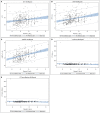Assessing Anticoagulation in Neonates With Congenital Diaphragmatic Hernia During Extracorporeal Membrane Oxygenation: Does Anti-Factor Xa or Thromboelastometry Provide Additional Benefit?
- PMID: 34604133
- PMCID: PMC8485026
- DOI: 10.3389/fped.2021.685906
Assessing Anticoagulation in Neonates With Congenital Diaphragmatic Hernia During Extracorporeal Membrane Oxygenation: Does Anti-Factor Xa or Thromboelastometry Provide Additional Benefit?
Abstract
Objective: The optimal management of anticoagulation in neonatal/pediatric patients during extracorporeal membrane oxygenation (ECMO) has not been established yet and varies greatly among ECMO centers worldwide. Therefore, we aimed to assess whether the use of anti-factor Xa assay and/or thromboelastometry correlate better than activated clotting time with heparin dose in newborns with congenital diaphragmatic hernia during ECMO. We also examined whether these coagulation assays correlate with thrombotic and/or hemorrhagic complications, when the management of anticoagulation is based only on activated clotting time values. Methods: A prospective observational study in a neonatal ECMO center was conducted. We included all neonates with congenital diaphragmatic hernia born in our institution between March 2018 and January 2019 and requiring support with venoarterial ECMO. A total of 26 ECMO runs were analyzed. During the study, the heparin dose was still adjusted according to activated clotting time values. Measurements of anti-factor Xa assay, activated partial thromboplastin time, and a thromboelastometry from the same blood specimen were performed twice a day. Results: Anti-factor Xa levels showed a moderate correlation with heparin dose, whereas the other tests showed a weak correlation. Four patients (17.4%) had thrombotic complications, 2 patients (8.7%) experienced life-threatening bleeding, and in 11 patients (47.8%) disseminated intravascular coagulation (DIC) occurred. Anti-factor Xa levels were lower in the group with thrombotic complications (0.23 vs. 0.27 IU/ml; p = 0.002), while activated partial thromboplastin time was higher in the group with hemorrhagic complications (69.4 s vs. 59.8 s; p = 0.01). In patients experiencing DIC, heparin dose and anti-factor Xa levels were lower, while no difference in activated clotting time and clotting time in INTEM and INTEM-HEPTEM were shown. Conclusions: Anti-factor Xa levels correlate better to heparin dose than activated clotting time. The use of anti-factor Xa assay instead of activated clotting time for dosing of unfractionated heparin could reduce thrombotic complications in neonates with congenital diaphragmatic hernia on ECMO support. The thromboelastometry showed no additional benefit for this purpose.
Keywords: anti-factor Xa; congenital diaphragmatic hernia; extracorporeal membrane oxygenation; heparin; thromboelastometry.
Copyright © 2021 Perez Ortiz, Dempfle, Jung, Doniga, Weiß, Hetjens, Schaible and Rafat.
Conflict of interest statement
The authors declare that the research was conducted in the absence of any commercial or financial relationships that could be construed as a potential conflict of interest.
Figures

Similar articles
-
Anti-factor Xa assay is a superior correlate of heparin dose than activated partial thromboplastin time or activated clotting time in pediatric extracorporeal membrane oxygenation*.Pediatr Crit Care Med. 2014 Feb;15(2):e72-9. doi: 10.1097/PCC.0000000000000028. Pediatr Crit Care Med. 2014. PMID: 24335992
-
Performance Assessment of a Multifaceted Unfractionated Heparin Dosing Protocol in Adult Patients on Extracorporeal Membrane Oxygenator.Ann Pharmacother. 2021 May;55(5):592-604. doi: 10.1177/1060028020960409. Epub 2020 Sep 22. Ann Pharmacother. 2021. PMID: 32959678
-
Conversion From Activated Clotting Time to Anti-Xa Heparin Activity Assay for Heparin Monitoring During Extracorporeal Membrane Oxygenation.Crit Care Med. 2020 Dec;48(12):e1179-e1184. doi: 10.1097/CCM.0000000000004615. Crit Care Med. 2020. PMID: 33009103
-
Anti-Factor Xa-Based Anticoagulation during Extracorporeal Membrane Oxygenation: Potential Problems and Possible Solutions.Semin Thromb Hemost. 2020 Jun;46(4):419-427. doi: 10.1055/s-0039-1697950. Epub 2019 Sep 28. Semin Thromb Hemost. 2020. PMID: 31563131 Review.
-
Anti-Xa-guided Anticoagulation With Unfractionated Heparin and Thrombosis During Extracorporeal Membrane Oxygenation Support: A Systematic Review and Meta-analysis.J Cardiothorac Vasc Anesth. 2024 Aug;38(8):1662-1672. doi: 10.1053/j.jvca.2024.03.042. Epub 2024 Apr 2. J Cardiothorac Vasc Anesth. 2024. PMID: 38839489
Cited by
-
Activated Clotting Time and Haemostatic Complications in Patients Receiving ECMO Support: A Systematic Review.J Cardiovasc Dev Dis. 2025 Jul 13;12(7):267. doi: 10.3390/jcdd12070267. J Cardiovasc Dev Dis. 2025. PMID: 40710792 Free PMC article. Review.
References
-
- Brogan T V., Lequier L, Lorusso R, MacLaren G, Peek G. Extracorporal Life Support : The ELSO Red Book. 5th Edn.Brogan TV, Lequier L, Lorusso R, MacLaren G, Peek G, editors. Ann Arbor: Extracorporeal Life Support Organization; (2017). 831 p.
-
- Liveris A, Bello RA, Friedmann P, Duffy MA, Manwani D, Killinger JS, et al. . Anti-factor Xa assay is a superior correlate of heparin dose than activated partial thromboplastin time or activated clotting time in pediatric extracorporeal membrane oxygenation. Pediatr Crit Care Med. (2014) 15:72–9. 10.1097/PCC.0000000000000028 - DOI - PubMed
LinkOut - more resources
Full Text Sources

